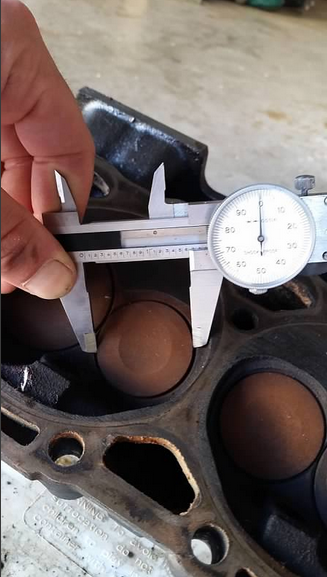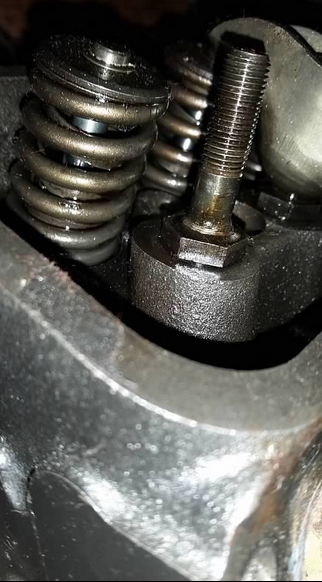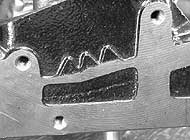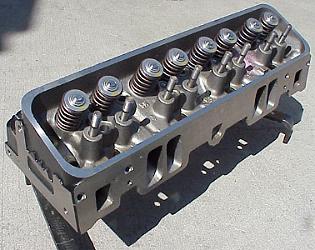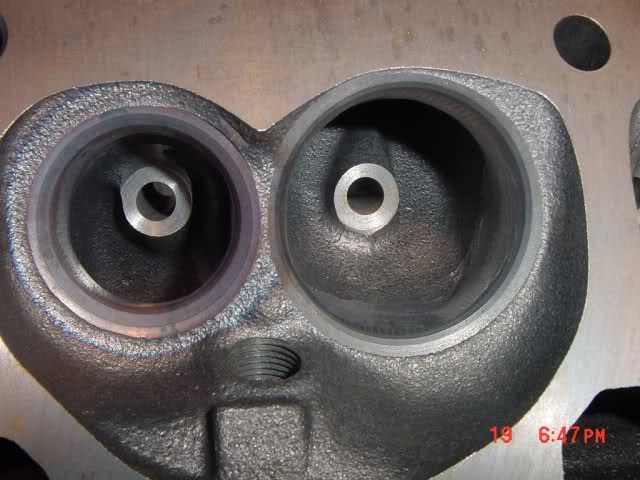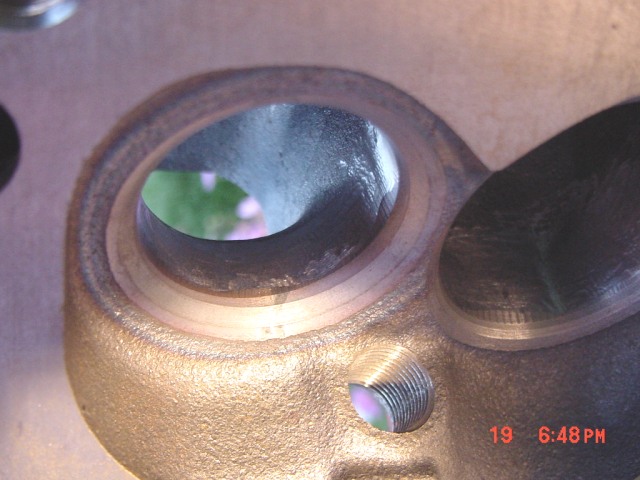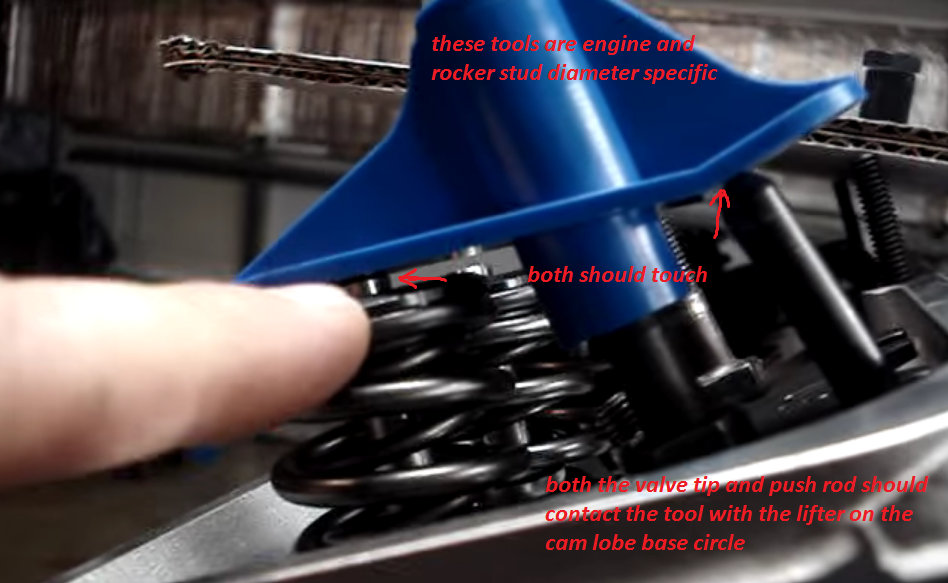The Science of Horsepower: Porting & Matching Heads & Manifolds.
Larry Carley, Underhood Service, November 2001
Air flow makes horsepower. The more cubic feet per minute (cfm) of air that flows through the intake ports and into the combustion chambers, the more horsepower the engine makes.
A larger carburetor or throttle body, bigger valves, a high-lift, long-duration camshaft, three-angle valve job and exhaust headers are all performance enhancements that increase air flow for more power. Add a turbocharger or supercharger and even more air is forced through the engine. But bolt-ons can accomplish only so much. To realize the utmost performance potential from a given combination of cubic inches and mechanical modifications, you also have to optimize the ports in the cylinder heads and match the ports to the runners in the intake manifold.
There are two ways to port and match cylinder heads: The right way and the wrong way. The right way is to refine the flow characteristics of the head and manifold so as much air as possible enters the cylinders at the engine’s peak power curve. Every engine is different so there’s no "standard" port configuration that is guaranteed to deliver maximum air flow on every application. The port profile that works best will be limited by the physical dimensions of the cylinder head.
Limiting factors include the size, position and angle of the stock ports; the size, configuration and angle of the valves; the thickness of the casting around the ports; and the location of the water jackets, head bolts and other valvetrain components. But other factors must be taken into account, too, such as engine displacement (big block versus small block), the engine’s bore and stroke, the shape of the combustion chambers, compression ratio, the depth and angles on the valve seats, total valve lift, camshaft profile(duration, overlap, etc.), and type of intake manifold and induction system.
Porting can unleash hidden horsepower by increasing air flow - but it requires know-how, a flow bench and special tools to successfully pull it off.
Opening Up
One of the basic goals of head porting is to minimize obstructions so air can flow relatively unimpeded from the throttle plate to the valves. Two things that get in the way are the valve guides and valve guide bosses. Cutting down the length of the valve guide stem and narrowing the valve guide boss can improve air flow past these obstacles. So too can using smaller diameter valve stems or valves that are necked down just above the valve head.
Bolt bosses that protrude into ports also create bumps in the ports that disrupt air flow. Grinding these flush with the surrounding port surface can also smooth out the route, provided you don’t run out of metal and grind all the way through the boss or dangerously weaken the head.
Transition areas in the port also need to be reworked so air will flow more easily around corners with a sharp radius and into the seat throat just above the valves. Sharp edges and rough castings also need to be smoothed and blended to eliminate turbulence and improve air flow.
The cross-sectional area of most intake ports becomes gradually smaller as the air moves toward the valve. This causes the air to accelerate as it approaches the valve, and actually helps ram more air past the valve into the cylinder when the valve opens. Any sudden changes in the cross-section of the port can disrupt this effect and restrict air flow. That’s why port modifications that are made in the area just above the valve must not upset the normal increase in air velocity. The same goes for the exhaust side, too, except here the cross-section of the ports gets larger as the exhaust gases flow away from the valves. Again, the secret to maximizing flow is to have a smooth transition and as few obstructions as possible.
The joint where the intake manifold and cylinder head meet also is a critical area. If the runners in the intake manifold are not perfectly aligned with the ports in the head, sharp edges can interrupt normal air flow and impair performance. Matching up the ports so there’s a smooth transition from manifold to head will ensure maximum air flow. The same goes for exhaust ports. The head ports must be aligned with the header openings so the exhaust gases can pass freely out of the engine without encountering any sharp edges or obstacles.
The right way to improve air flow is to locate the best places to remove metal (or in some cases, to even add metal). This takes experience (knowing what kind of changes work and what ones don’t), using the right tools (properly shaped cutters for reworking the various portions of the ports, valve pockets and manifold), and a flow bench to measure the changes in air flow produced by the various changes that have been made.
The wrong way to go at it is to grab a die grinder and start hogging out the intake and exhaust ports with no idea of where you’re going or what you’re trying to accomplish other than to open up the ports.
Bigger is not always better. Grind away too much metal and you may end up ruining the casting if you cut into a water jacket. But even if you don’t grind all the way through, removing metal in the wrong places can actually end up hurting air flow more than it helps.
Here’s why: The secret to maximizing air flow and engine performance is maximizing volumetric efficiency and air flow velocity.
Big ports with lots of volume will obviously flow more air than a smaller port with less volume - but only at higher rpm. A lot of people don’t know that. At lower rpm and mid-range, a smaller port actually flows more efficiently and delivers better torque and performance because the air moves through the port at higher speed. This helps push more air and fuel into the cylinder every time the valve opens. At higher rpm, the momentum of the air helps ram in more air, so a larger port can flow more air when the engine needs it.
The ultimate port would actually be one with a variable cross-section that’s small at low rpm for high air flow velocity and gradually opens up for more air flow as engine speed increases. That’s sort of the idea behind staged split-plenum intake manifolds that open up and feed more air into the engine at higher rpm.
The bottom line is this: To realize the most power and performance out of an engine, air flow has to match the breathing requirements of the engine within the engine’s rpm range where it is designed to make the most power.
A set of killer aftermarket heads with huge ports and valves that are engineered to flow more than 500 cfm with a 0.800" valve lift at 8,000 rpm may be the hot setup for a 585-cubic-inch Pro Stock engine, but would be overkill on a street-driven, big-block Chevy that has a less radical cam, gearing and a redline of only 5,500 rpm. That’s why big-block Chevy heads with smaller oval ports work better on the street, and big-block heads with larger rectangular ports perform better on the strip.
Therefore, when choosing either an OEM cylinder head or an aftermarket head, you should try to match the port size with the engine’s power curve and rpm range. Don’t waste your money bolting a set of high-flow heads onto an engine that can never realize the head’s full performance potential because of limitations in gearing, the valvetrain, cam specifications or carburetion. Likewise, if you’re going all out, then start with the highest flowing heads you can find and try to add even more cfm potential by massaging the ports and manifold.
Kevin Self of Self Racing Heads & Engines, Durant, OK, said CNC (computer numeric controlled) machined aftermarket heads are a great place to start because the port configurations are based on designs that have already been proven to deliver maximum air flow. Even so, there’s always some room for improvement. Self said he can usually find an additional 25 to 30 cfm improvement in air flow in many CNC heads by tweaking the head on a flow bench.
"One of the advantages of CNC heads is that they all have very consistent flow characteristics. But, because they’re all the same, you don’t necessarily gain any advantage over a competitor if he buys the exact same set of heads as you. If you can’t improve the head, you’ll have to find more horsepower someplace else, otherwise you’re not going to go any faster than the next guy." CNC machining is much faster than hand grinding, and produces ports that have uniform profiles. But someone still has to develop the initial profile by hand and then prove it works on a dyno and on the track.
As for port alignment, Self said the runners in the intake manifold should be about .050" smaller than the port opening in the cylinder head to allow for any misalignment that occurs during engine assembly.
"We’ve developed a special ‘Port Intruder’ kit that allows you to narrow the thickness of the wall between the intake ports on small-block Chevy heads without increasing the risk of cracking the manifold or deck area of the head. The kit allows the use of a shorter head bolt between the ports, eliminating the need for a head bolt or bolt sleeve between the ports. The head must be machined to accept the Port Intruder plugs. This change alone can increase air flow up to 30 cfm," said Self.
Bob Irvin of M2 Race Systems, Farmingdale, NJ, said his company specializes in CNC-machined cylinder heads. "We use outsiders to develop the port configurations, then digitize the ports for reproduction on customers’ cylinder heads." Irvin said he charges a one-time fee of $2,000 to digitize and program a port configuration, and $1,200 to $1,500 to CNC machine a pair of cylinder heads (which includes valve seat and guide work, too). "CNC is foolproof and is much faster than trying to port a set of heads by hand from scratch. But there’s no reason why you can’t do additional finishing on the heads after they’ve been CNC machined to find some extra power," said Irvin.
Where It Counts
As a rule, the roof of an intake or exhaust port has much more influence on air flow than the floor or sides of the port. The greatest gains in air flow can often be realized by removing metal from the top of the port only and leaving the sides and floor relatively untouched. This can have the same effect as using a different head casting or an aftermarket head that has the ports relocated slightly higher to give a straighter shot at the valves.
Additional gains in air flow can often be found by carefully smoothing and blending the short-side radius in the port floor where the port bends toward the valve seat. This helps air round the corner more easily for improved air flow.
In the area where the intake manifold and head are bolted together, using a template to scribe alignment marks on the head and manifold can serve as a guide for hand grinding and smoothing this area.
Mr. Gasket Company’s plastic "UltraSeal Port Gauge" templates for small-block and big-block Chevys can be used for this purpose, and are much more accurate than using a gasket as a template.
Expert Advice
Joe Mondello, who’s name has long been synonymous with high-performance cylinder heads, said a lot of people who don’t really know what they’re doing jump into head porting and make big mistakes. "They take out metal where they shouldn’t be taking out metal and end up with ports that are too big and don’t flow as well as they should. The shape of the port is far more critical than the overall size of the port," stated Mondello.
Mondello, who teaches the secrets of building, porting and flow testing high-performance cylinder heads at his Mondello Technical School in Paso Robles, CA, said he also sells special porting tools that are designed for every part of the cylinder head.
"When you’re doing the short-side radius of a port, you don’t want to take out too much metal. You just want it to be nice and smooth," instructed Mondello. "Trying to get around the short-side radius bend is difficult unless you use a cutter that’s designed for that purpose. "When cleaning up the bowl area, blending alone won’t improve flow unless you also remove some metal to increase volume. Many people don’t do valve bowls properly. You have to blend everything from the base of the valve guide to the base of the primary valve seat, and then do a 3-angle valve job. Otherwise you’re just scratching the valve bowl and ports, and aren’t really gaining anything."
As for matching ports, Mondello said not to use gaskets as a guide because there’s too much variation in gaskets and most aftermarket gaskets have openings that are up to 1/8" larger than the port runners. If the port is enlarged to match the gasket, it can reduce air velocity and hurt performance. "We teach port matching, not gasket matching. I pick the largest port, match all the others to it, then do all the work inside the port to maximize air flow around the pushtube turn because that’s where the biggest restriction is in the port," said Mondello.
"The largest gains in horsepower are found on the intake side by raising the roof of the port (the side closest to the valve cover) by .100" to .175". The amount of metal in the top of the intake manifold runner will determine how high you can raise the roof.
"On late-model Chevy Vortec heads, you don’t want to change the shape of the port much. The best advice here is to clean up and equalize the ports so they have the same height and width. On small-block heads, there’s a large pocket right below the rocker arm stud in the roof of the port. This should be filled in with epoxy to improve air flow. Doing that will give you an extra 15 cfm.
"On exhaust ports, if you tried to match the port to a header gasket you’d probably destroy the port. The secret of exhaust porting today is not how big the port is, but the shape of the port and the velocity of the exhaust flowing through it. We don’t even flow test exhaust ports anymore because most heads have plenty of flow capacity as is. All we care about is velocity and pressure. "Nearly every single exhaust port today, except for Ford 302, 5.0L and 351 heads, are big enough. The only thing we do to enhance air flow is raise the roof of the port about 0.100", depending on the headers used. We don’t touch the floor of the exhaust port or the sides unless we have to get rid of a hook, seam or rough area in the casting," said Mondello. "Any time you start making the ports bigger on the exhaust side, you usually end up killing air flow in the head. I’m talking a reduction of 25 to 30 cfm. All you need to do is clean up the valve bowl, blend the short-side radius, and raise the roof slightly. Don’t touch the floor or walls."
Mondello explained that CNC machining and hand grinding are two different techniques for porting heads. "Everybody says CNC is the way to go. But you first need someone who can take a raw casting and rework it so it has good air velocity and flows well. Then you can digitize it and reproduce it with CNC tooling on other heads. There are a lot of CNC profiles being sold today, but I think most have some room for improvement. Additional hand grinding can usually pick up another 10 to 12 or more cfm."
As for polishing, Mondello said a smooth finish is great for exhaust ports, but a rougher finish flows better on the intake side. He recommends using 300- or 400-grit paper followed by a Cross Buff for polishing exhaust ports, and 50- or 60-grit paper for the intake ports. A slightly rough surface texture in the intake ports and intake manifold runners creates a boundary layer of air that keeps the rest of the air column flowing smoothly and quickly through the port.
DIY Porting
Though the greatest gains in horsepower will be realized only when heads are flow tested and professionally ported, do-it-yourselfers who are racing on a limited budget can still do some basic porting themselves to improve air flow and increase the performance potential of their engines.
The technical staff at Standard Abrasives (
www.sa-motorsports.com) have an online DIY Cylinder Head Porting Guide complete with photos that provides detailed step-by-step instructions for head porting and manifold matching.
All you need are a basic porting kit (which includes various grinding stones and abrasive rolls), some common tools and some free time (typically 10 to 12 hours to port a pair of V8 heads). A basic DIY port job should focus on reducing restrictions caused by steps that may obstruct intake air flow as it transitions from the intake manifold to a smaller intake port entry in the head. These restrictions could be casting bumps, ridges or other marks, such as those on port floors or roofs, sharp edges, such as those around the valve guide bosses at the top of the valve pockets, and the area where the intake port floor curves down to the valve seat.
The job itself consists of six steps:
1. Enlarging and matching the intake port entrances;
2. Smoothing the intake short-side radii, valve guides and valve pockets;
3. Smoothing the exhaust short-side radii, valve guides and bowls;
4. Polishing the exhaust ports and bowls;
5. Polishing the combustion chambers (to reduce carbon buildup)
6. Matching the intake manifold ports to the head.
Some porting suggestions offered by Standard Abrasives include:
• Use an air-powered die grinder with a maximum speed of 18,000 to 20,000 rpm and a 1/4" collet. An electric die grinder is OK, but you have to be careful to limit the grinder’s speed.
• Wear proper eye protection. Grinding throws off a lot of chips, and you don’t want any debris to end up in your eyes. Good lighting is also essential so you can see what you’re doing, and gloves are recommended to protect your hands.
• To keep grinding stones from clogging when working on aluminum heads, lubricate the stones with WD-40.
• To figure out how much metal needs to be removed to match up the ports, apply machinists bluing to the gasket template and bolt the template to the head and manifold. Then scribe the outline of the port opening on both the head and manifold. Remove all metal inside the scribed lines.
• When you start grinding, use a rotary round grinding stone for maximum metal removal. As you approach the scribe marks you’ve made, blend or feather the larger port into the remaining port by progressively removing less material as you move farther down into the port. In most cases, you want to grind about 1" to 1.5" into the port.
• Once the port has been ground to size, switch to a smaller diameter conical rotary stone to profile the small radii at the corners of each port.
• To finish the port, use the tapered rolls of abrasive, starting with 40 grit, then 80 grit.
• The point where the intake port floor curves down to the valve seat is known as the "short-side radius." From an air flow standpoint, this area is the most critical in any port. Smooth that spot and you can usually realize a significant increase in flow through the port. On most production heads, the short-side radius will be sharp-edged and rough. The goal here is to soften those sharp edges and smooth out the roughness.
• Bowl work includes blending the area under the valve seat. The valve throat, which is the smallest diameter in the valve pocket just above the valve seat, should be about 85% of the valve diameter. If the throat is smaller than that, use a combination of the rotary stone and cartridge rolls to open it up to the 85% figure.
• Exhaust ports flow best with a polished finish. A smooth finish also helps reduce the buildup of carbon deposits. Use a 120-grit or finer flap wheel after using the 40-grit and 80-grit abrasives, then polish with the medium Cross Buff and finally the fine grade Cross Buff.
• In most cases, you should not attempt to match the exhaust ports in the head with the ports in the exhaust manifold or headers. Many stock exhaust manifolds, and virtually all tube headers, have larger port sizes than the heads. You want that "step" from the port to the larger header tube or exhaust manifold because, as pressure pulses flow back and forth in the exhaust system, it acts as a "reversion dam" by resisting back flow of exhaust gases into the port.


